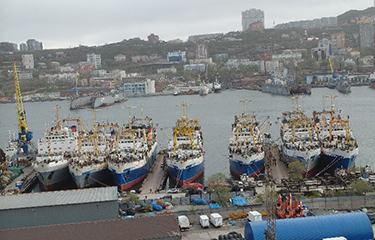Russia decreases pollock TAC for 2022 as biomass declines

Russia's Ministry of Agriculture has announced that the country’s total allowable catch (TAC) for pollock in 2022 will be decreased from 1.996 million metric tons (MT) to 1.927 million MT.
The decision comes soon after the Russian Research Institute of Fisheries and Oceanography (VNIRO) said there may be a decline in the pollock biomass in the Sea of Okhotsk, the primary source of Russian pollock. In late October, VNIRO presented results of research on the stock in the Sea of Okhotsk showing signs of a possible decline in biomass of the species.
The TAC for pollock in the Sea of Okhotsk in 2022 has been set accordingly at 956,000 MT, a reduction of 104,000 MT from the 1.06 million MT TAC set for 2021. That is further divided into three subzones: 344,200 MT for the Northern Sea Okhotsk subzone, 344,200 MT for the Western Kamchatka subzone, and 267,200 MT for the Kamchatka Kuril subzone.
According to VNIRO, research showed signs of a possible decline in the biomass of the species compared to 2020. The research found a low level of recruitment from the generations from 2017 to 2020.
“That’s a very alarming sign. The trend can negatively affect the stocks of the Sea of Okhotsk over [the] near-term,” VNIRO stated. “From 2024 on, there may be a significant decrease of the biomass of the species that will lead to a drop in the total allowable catch.”
The drop reverses an upward trend in pollock biomass that Russian companies have enjoyed for the past several years. The TAC in 2021 was 1.7 percent higher than in 2020, and over the last several years, the TAC typically grew by between 80,000 and 100,000 MT each year.
However, the news didn’t come as a complete surprise, as Russian companies have been preparing for the potential end of the upward trend in pollock TACs. In recent years, companies have shifted focus toward deeper processing, adding capacity to produce surimi, fillet, and mince segments.
The drop in TAC may not be a major issue for Russian seafood companies, as many either haven’t – or don’t want to – catch more pollock. In late 2020, Russia’s trade relationship with its top pollock export market destination, China, became strained as the country tightened its inspections on imported seafood after it claimed traces of COVID-19 had been found on the packing of imported seafood products. Russia's pollock A season, which runs from January through April, brought in a catch of 858,000 MT, the Pollock Catchers Association (PCA) said in a press release. That result was 14 percent lower than 2020's A season, despite a higher TAC. In the Sea of Okhotsk, the harvest dropped 15 percent compared to the same period last year.
In the first half of 2021, Russian seafood shipments to China decreased 83 percent by volume compared to 2020. The drop was enough that China is no longer the number-one export destination for Russian seafood, with South Korea claiming the top spot.
In response, Russian seafood companies and the Russian government have committed to a joint effort to increase pollock consumption in the domestic market and to open new markets. Russia's government has looked into making bulk purchases of domestically-caught pollock and the country's exports to previously unheralded markets such as Thailand, Vietnam, Indonesia, and Namibia have increased.
In terms of the domestic market, logistics problems have proved one of the biggest obstacles. The government is considering whether to adopt a rail-transportation program that would subsidize the high cost of shipping frozen pollock from the sparsely populated Far East – where most of Russia's pollock is caught – to the country's more-populated West. However, the legislation has yet to become law.
Through October 2021, Russia's overall pollock catch total was a few percent behind the same period in 2020. Despite the drop in catch, the CPA said the renewed focus by Russian companies on value-added pollock products appears to be paying off. The output of pollock fillets increased by 17 percent, and mince by 21 percent. The share of raw materials processed into those products was 24 percent of the total pollock catch, compared to 17 percent in 2020.
Photo courtesy of Russian Fishery Company






Share